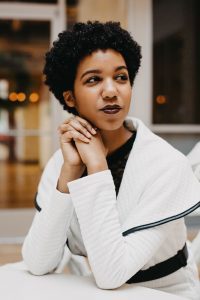Natalia Perez
 When I was 16, I got my first job at McDonald’s. I was determined to start my own savings and be able to purchase most of my own things.
When I was 16, I got my first job at McDonald’s. I was determined to start my own savings and be able to purchase most of my own things.
I saw a lot of different types of people on the job: druggies, frazzled moms, dads who would tell me their life stories while I rang up their fries, and middle-aged Hispanic men or young black men who would question me on my ethnicity.
“So. like, you’re not black, right?”
“Are you, like, mixed?”
And the dreaded: “I figured you couldn’t be black, you’re so pretty.”
And the: “Oh wow, you’re pretty for a black girl.”
(for a black girl? I’m sorry, what?)
The first time I heard it was like a punch to the face by a stranger (literally, but with words). Like, how do I make him aware that he just verbally punched me when he thinks what he said is a compliment?
For years, I’ve just kinda shrugged it off, seemed as if I didn’t really understand what the person was saying, and just moved the conversation literally anywhere else.
The standards of beauty and intelligence that have been praised and cultivated by the colonizer have then been adopted and cultivated by the colonized.
Issues of colorism run so, so deeply within Hispanic/Latin American and African American communities, and it’s very much become an “us vs. them” situation: light-skinned women vs. dark-skinned women. It’s an age-old oversimplification that really boils down to the belief that the lighter your skin tone, the more beautiful and valuable you are.
In the context of beauty, lighter skin is the metric of success in many communities. The standards of beauty and intelligence that have been praised and cultivated by the colonizer have then been adopted and cultivated by the colonized. They’ve been ingrained in us, to the point where, especially in Hispanic/Latin American communities, it can be so subtle you almost don’t even notice it. Almost.
It took me years to pin down why these comments bothered me as much as they did. As much as I love my people and our culture, I do believe we can be pretty racially unaware, in the sense that many of us are not completely — if at all — in touch with the effects of colonization in our culture and perspectives.
So growing up in a Hispanic community, we never touched race relations in America or its skewed beauty standards. We just kind of existed, handling things as they came. Everything was as it was for a reason and we didn’t explore too deeply as to how those reasons came to be.
Many of our perspectives are eurocentric, but not many of us are aware of it, especially if our families are first-generation immigrants. My parents’ major priority when coming to the States from Puerto Rico and the Dominican Republic was figuring out how to survive and integrate into “American culture,” and the hardships they faced were much different than the ones I’ve had to navigate.
Since it’s typically believed that kinky hair, dark skin and beauty are mutually exclusive, I remolded myself to fit the standard as best possible.
I remember attending our Hispanic SDA church every week on Sabbath as a young girl, carefully examining the women gathering in the ladies’ room, praising each other on their straightened hair. I enjoyed being praised for my own straightened mane when my time came along. I’d successfully assimiliated; I belonged.
I also remember noticing that our worship styles, the hymns we sang and our promotional materials presented, featured, well, — only white people. I noticed a lot of things but rarely questioned much. This was just the way things were. This was the way the world was run.
Our standards of beauty were what I most deeply grappled with throughout my life. Since it’s typically believed that kinky hair, dark skin and beauty are mutually exclusive, I remolded myself to fit the standard as best possible. For years, I presented a fabricated version of me, one with long straight hair. It took me longer than most to feel the disconnect within myself.
Once my college years beckoned, I realized I was exhausted of trying to reach a standard of beauty that would never truly be my own, and I chopped off all of my hair. I dreaded confessing this to my very conservative mother. Telling my less conservative father, who also religiously altered the texture of his own hair, was probably scarier. The scariest was facing my church, who’d only known me as the former version of myself.
Going back as a newly discovered Afro-latina wasn’t as bad I thought, but I had a few frustrating interactions. My friend’s father put his hands in my ‘fro as soon as he saw me.
“It’s like a sheep!” he said, laughing. I was less than pleased.
His wife walked over to me a few minutes later, exclaiming in disappointment.
“Natalia, what have you done? I don’t like it. You look crazy! Te vez loca!” she said.
I mustered all of the patience within me, along with some of the patience only God could give, and looked down at her.
“Amor,” I said. “If you don’t like it, you don’t have to look at it. But why do you think it’s crazy? This is how God created me. This is the way the hair grows out of my head naturally. I don’t think embracing that is crazy.”
She stared at me for a few moments and walked off. I’m not sure what her thought process was after that exchange because she hasn’t spoken much to me since then.

I don’t share this to sound like a sob story, but to bring to light that there’s much to be done in race relations and cultural understanding not just within black and white spheres, but also within the Hispanic population.
The diversity within our church is powerful, and we can harness it to its full potential only by intentionally striving to understand each other, embracing the beauty in each of our cultures.